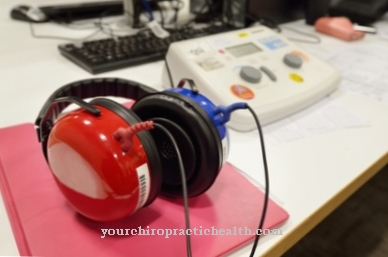A Speech audiogram instead of sounds reproduces human speech through headphones. These can be words or numbers that are repeated. The speech audiogram is an important way of examining hearing disorders and is also used when fitting hearing aids.
What is the speech audiogram?

The speech audiogram is similar to a tone diagram. However, the speech audiogram does not play sounds or sounds that are supposed to be perceived by the test person, but numbers, words or individual syllables. Since these recordings are made at set volumes, the speech audiogram is a good method of determining speech understanding.
A language diagram, also under the name Speech intelligibility test known, shows the different perception of the test person between the current hearing ability and speech understanding. Testing using a language diagram can be carried out in different ways. There are so-called syllable tests, word tests and sentence tests. The various tests enable a good clarification of how high the hearing ability and the equally important language understanding are. In the syllable test, individual mostly meaningless syllables are played, which are then repeated by the test person. In the so-called Freiburg word test, monosyllabic nouns and numerals are played through headphones or loudspeakers.
Numerals should be easy to understand and recognized as correct even at a low sound pressure level. People with hearing loss, even with a good level and an existing sensorineural disorder, no longer understand all words that are monosyllabic. The focus of the tests are two-digit, often four-syllable numerals or monosyllabic words such as farm, slope or ring. By grouping the words, the hearing loss can be measured in terms of numbers, but also in a discrimination loss. The sentence test with full sentences reflects the everyday situation better.
Function, effect & goals
The speech diagram is used in particular to clarify suspected factors of hearing loss and other disorders in the hearing area. The necessary tests serve as a guide to how much the person concerned hears or understands. The increase in volume ends as soon as the test person can repeat the played words, numbers or syllables without making any mistakes.
If the errors persist despite a higher volume, the system switches to the next higher volume. The required volume that the person concerned needs to understand is an important value for the ENT specialist. Through the measurement carried out with the speech audiogram, the specialist then determines whether one-sided or two-sided supply with hearing aids is necessary for the hearing aid supply.
The speech audiogram varies from person to person and takes between ten to 20 minutes. In the number test, ten groups of ten two-digit numbers each are played, in the word test 20 groups with 20 monosyllabic nouns each. The number of words correctly understood is the percentage of the total number of words that are tested for intelligibility and discrimination. The order in which the word groups are played is irrelevant.
However, it is important to check a complete group for the correct execution of the speech diagram. Each group is coordinated with one another with regard to the composition of the sounds it contains, in order to ensure a qualitative examination of the hearing ability. If you mix the words, the balance decreases and the meaningfulness of the test is reduced. The speech audiogram starts with a speech sound level that is ten to 20 decibels above that of the hearing loss, at 1,000 Hz.
If more than half of the numbers are correctly understood, the next group is tested at a speech sound level that has been reduced by ten decibels and vice versa. Because they are more difficult to understand, the monosyllabic words are played at a speech sound level of around 30 to 40 decibels above the value where a good half or more monosyllables are still correctly understood. Experience has shown that it is advisable not to start the monosyllable test too quietly. Under certain circumstances, this could lead to the patient becoming tired early on or losing interest in the important examination. The main goal of the monosyllabic test is to find the appropriate speech sound level at which the monosyllables can be understood or to achieve an optimal value which, according to the current test results, cannot be increased.
At least three groups should be tested on the monosyllabic test to achieve a good result. It doesn't really require 100 percent intelligibility. If the result is 95 percent, it is okay to recognize the word as fully understood, because internal or external influences sometimes mean that a word is not understood. When fitting a hearing aid, the test is important to find out how far this speech sound level can be increased until the discomfort limit is reached. This tolerance test shows in which range someone has their maximum speech understanding, which for a normal hearing person is between 50 and 100 decibels.
You can find your medication here
➔ Medicines for ear complaints and hearing problemsRisks, side effects & dangers
The risks associated with using the voice diagram are the patient himself and possible disorders that could falsify the test result. The patient has to actively participate in the speech diagram and not show a lack of interest or commitment, lack of time or the like. be tempted to take the tests carried out and the words, numbers or syllables that have been carried out less seriously.
This can be stressful for people who fear a possible hearing impairment or hearing aid fitting. In addition, the devices used must function properly for the correct execution of the speech diagram - this is the only way to ensure a meaningful measurement and the resulting measures.












.jpg)



.jpg)










.jpg)
